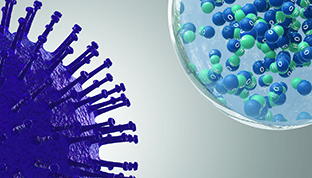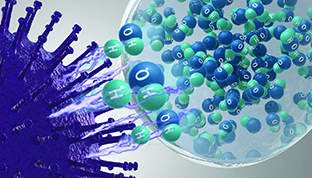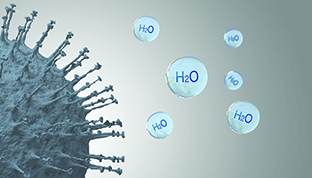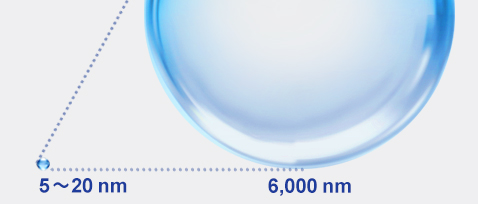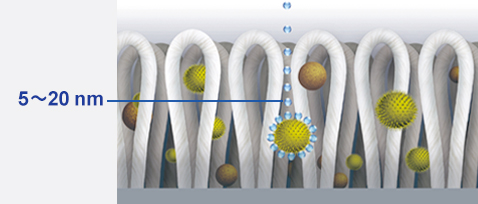The technology of hydroxyl radicals contained in water
An abundance of hydroxyl radicals
Huge volumes of hydroxyl radicals contained in water are released into the air. These hydroxyl radicals can remove hydrogen contained in airborne bacteria*¹, inhibiting their effect. The greater the volume of hydroxyl radicals, the greater the effect*¹ expected.
How hydroxyl radicals contained in water inhibit the activity of bacteria
Hydroxyl radicals contained in water live longer and spread more widely
Hydroxyl radicals contained in water are surrounded by about 1,000 times*² more water (by volume) than general negative ions. Further, whereas the lifespan of general negative ions ranges from just tens of seconds to 100 seconds, the lifespan of hydroxyl radicals contained in water is about 600 seconds (Panasonic research). Hydroxyl radicals contained in water have a longer lifespan and disperse across a wider area.
General negative ion | Hydroxyl radicals contained in water | |
|---|---|---|
Ion | 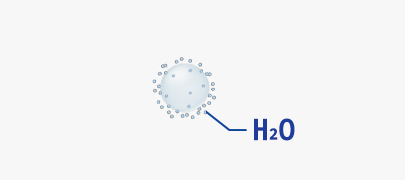 | 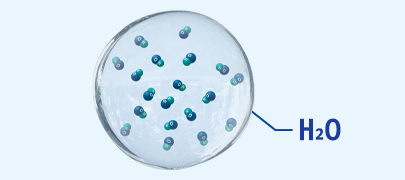 |
Extended lifespan mechanism | 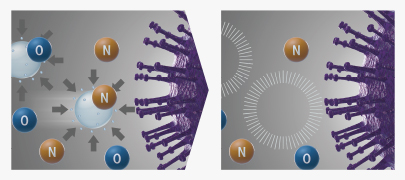 General negative ions do not readily reach bacteria because they tend to bind to the abundant oxygen and nitrogen in air. | 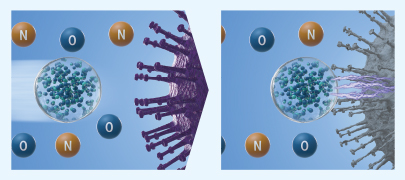 Hydroxyl radicals contained in water do not bind to oxygen or nitrogen, as these elements do not readily dissolve in water, so they reach and inhibit bacteria. |
Air flow analysis of dispersion trajectory |  The lifespan of general negative ions is tens of seconds to 100 seconds. |  The lifespan of hydroxyl radicals contained in water is about 600 seconds. |
Penetrates deep into fibres
Nano-sized hydroxyl radicals contained in water penetrate deep into fibres, surrounding allergens*³ (pollen, mite faeces/carcasses, etc.), inhibiting their activities.
Mildly acidic, gentle on skin and hair
Hydroxyl radicals contained in water are mildly acidic and gentle on the human body. The effect on skin and hair has been confirmed.*⁴
Safety verification
The safety of hydroxyl radicals contained in water has been tested, with the following results.
Test purpose | Test name | Testing organisation |
|---|---|---|
Impact on chromosomes | Chromosome abnormality test using cultured cells | Japan Bioassay Research Center*⁵ |
Impact on respiratory organs | Repeated administration toxicity test | Life Science Research Laboratory*⁶ |
Toxicological and carcinogenic impact | Chronic toxicity and carcinogenicity combined test | Food and Drug Safety Center, Hatano Research Institute |
Impact on DNA | Comet Assay | Food and Drug Safety Center, Hatano Research Institute |
Impact on male and female fertility and unborn children | Simplified reproductive toxicity test | Food and Drug Safety Center, Hatano Research Institute |
The technology of hydroxyl radicals contained in water is expected to have many applications
*¹ Effect after 4 hours in a test room of approximately 25 m³, not in an actual use environment
Testing organisation: Kitasato Environmental Science Center
Test method: Measuring airborne bacteria in an approximately 25 m³-sized room
Inhibition method: Releasing hydroxyl radicals contained in water
Target: One type of airborne bacteria
Test result: Inhibited more than 99% of bacterial activity in 4 hours (Report No. 24_0301_1)
*² Comparison between general negative ions (typical particle size: 1.3 nm) and hydroxyl radicals contained in water (typical particle size: 13 nm) (Panasonic research)
*³ Effect after 8 hours (pollen) and 24 hours (mite faeces/carcasses) in an approximately 23 m³-sized test room, not in an actual use environment
Testing organisation: Panasonic Corporation Product Analysis Center
Test method: Measurement of allergens adhering to a cloth in an approximately 25 m³-test room using the ELISA method
Inhibition method: Releasing hydroxyl radicals contained in water
Target: Adhering allergens
Test results: Inhibited at least 88% of bacterial activity in 8 hours (BAA33-130402-F01)
Inhibited at least 60% of bacterial activity in 24 hours (BAA33-130304-F04)
*⁴ Verified the results of exposure to hydroxyl radicals contained in water for 4 weeks (skin) and 2 weeks (hair) of continuous use. Individual results may vary based on usage, and seasonal and environmental variables (temperature and humidity). For areas of skin and hair not exposed to hydroxyl radicals contained in water, no effect can be expected.
Testing organisation: FGC Research Institute, Ltd.
Test method: 20 women 40±2 years old participated. 10 women operated a device generating hydroxyl radicals contained in water at home for 28 days, while the other 10 operated a device that does not generate hydroxyl radicals contained in water at home for 28 days and their skins were compared.
Skin beautification method: Releasing hydroxyl radicals contained in water
Testing organisation: Panasonic Product Analysis Center
Test method: In a test room of 50 m³ at a room temperature of 25 ℃ hair bundles (6 bundles) were suspended 2 m from a generator of hydroxyl radicals contained in water which was operated for 8 hours, then turned off for 16 hours. This cycle was repeated and measurements were taken.
Hair beautification method: Releasing hydroxyl radicals contained in water
Target: Hair bundles
*⁵ Japan Bioassay Research Center and Food and Drug Safety Center are GLP-compliant facilities. GLP aims to secure reliability of various safety test results on chemical substances, and confirms compliance with the GLP standard by testing institutions and ensures reliability of test results.
*⁶ The Life Science Research Laboratory is a registered institution of the Cause Investigation Institution Network, administered by the National Institute of Technology and Evaluation, an independent administrative agency of Japan’s Ministry of Economy, Trade and Industry.
* Individual results may vary based on usage, and seasonal and environmental variables (temperature and humidity). Hydroxyl radicals contained in water inhibit the activity of viruses and bacteria but do not prevent infection.


